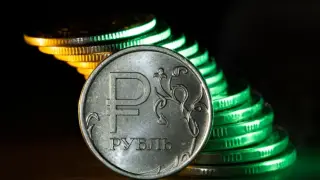The share of money transfers from Russia decreased to 14.2% in the third quarter of 2024, placing the country in the third position. The statistical figures are at their lowest levels since the beginning of the Russia-Ukraine war both in terms of share – 14% and amount transferred – USD 124 million.
A total of USD 872 million was transferred to Georgia from foreign countries from July to September in the current year. The United States ranked first with USD 150 million, followed by Italy with USD 148 million, whilst Russia placed third with USD 124 million. For comparison, USD 195 million was transferred from Russia in the third quarter of 2023 and USD 385 million in the third quarter of 2022.
Although Russia consistently held the leading position in money transfers over the years, its share gradually declined due to the growth in transfers from other countries. Notably, whilst Russia accounted for 54% in transfers in 2013, its share had declined to 18% by 2021. The downward trajectory continued in early 2022, with the share dropping to 13% in the first quarter. However, this metric experienced a substantial increase, reaching 60% in the fourth quarter of 2022, resulting in an annual average of 47%.
Graph 1: Russia’s Share in Money Transfers
Source: National Bank of Georgia
Russia’s share decreased to 37% in the second year of the war and has since declined further to 18% in January-September of the current year. Whilst Russia remains first for the nine-month period with USD 446 million, it is closely followed by the US and Italy with USD 424 million and USD 417 million, respectively. If the transfers in the fourth quarter are distributed in the same manner as in the third quarter, Russia will likely lose its leading position in the annual data. In any case, Russia’s share is expected to remain below 20% this year, unless there is a sudden significant change, which is currently not anticipated.
Russia maintained its unnaturally high share in money transfers for five consecutive quarters. Russia announced partial mobilisation in September 2022, contributing significantly to the growth in the movement of migrants and transfers from the country. However, this share began to decrease substantially in the second half of 2023, gradually falling to pre-war levels.
Graph 2: Russia’s Share in Money Transfers
Source: National Bank of Georgia
The National Bank of Georgia does not categorise money transfers by the nationality of recipients, making it impossible to determine the proportion of the amounts received by the citizens of Russia as compared to the citizens of Georgia. In total, 17% of Russian citizens were either residing in Georgia or planning to stay for more than one year as of 30 June 2024.
Whilst money transfers do not directly participate in forming the gross domestic product (GDP), they significantly impact one of its key components – consumption.
Excluding certain exceptions reliance on transfers has been steadily increasing in the past years. The share of transfers in the total economy constituted 6.2% in 2003, 10.7% in 2012 and 15.6% in 2022. This ratio reached a record high in 2021 even before the war, reaching 14.2%. However, it fell to 13.8% in 2023. Reliance on transfers is expected to further decrease in 2024, considering the monetary decline in money transfers (decreased by USD 727 million, falling to USD 2.5 billion in the nine months as compared to the same period last year) and economic growth.
The negative net migration exceeded 285,000 from 2013 to 2023. The migration processes increased rapidly in recent times. Over 118,000 Georgian citizens left the country from 2022 to 2023 as compared to those who returned. This high rate of migration has accelerated the growth in money transfers; however, it should also be noted that transfers also increased in 2020 when there was a positive net migration due to the pandemic.
The volume of transfers from the US has significantly increased recently. Transfers from the US to Georgia reached USD 317 million in the first seven months of the current year, more than double as compared to the figure of the same period in 2021. Furthermore, the volume of transfers from the European Union is steadily increasing. The aggregate share of transfers from the US, the EU member states and Great Britain exceeds 60%.






